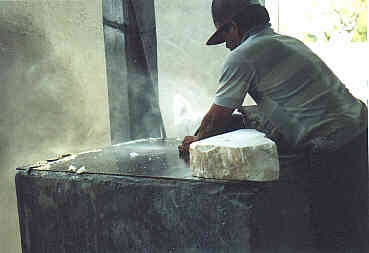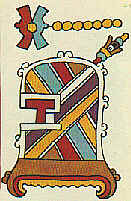The Bead SiteHome>Beadmaking and Materials>Stones > Tecali
Tecali, The Other Precious Stone of Mexico
Mexican onyx is travertine (see "the Onyx problem"). It is found near the village of Tecali, itself near Puebla. The Nahuatl (Aztec) name for the stone is Tecali, formed from the prefix for stone (te- from tetl, stone) to calle, meaning house. Thus, the word means, "house of stone." This is appropriate as the name of a village. It is, however, odd that the stone is named for the village, and not the other way around.
The stone tecali was widely used in pre-conquest Mexico. I know of no Olmec use, but the Maya, Aztecs, Zapotecs and others favored it for masks and other artifacts. Alfredo Caso (1938:37-8) in a popular book listed a tecali vase, perhaps made to hold sacrificial blood, as one of thirteen "masterpieces" in the Museum of Anthropology in Mexico City.
The Spanish also liked the stone. Many old churches in Mexico City and Puebla are decorated with it, carved into statues and pulpits. They also installed thin sheets as windowpanes before they began a glass industry in Puebla in 1542. More recently, it has been widely employed for internal decorations and the dome atop the Palace of Fine Arts in Mexico City, completed in 1934.
|
The current knickknack industry of Tecali turns out everything from rosaries to elephants.
I was told it had been operating only fifty years. This reflects the change in the way all crafts, including beadmaking, have been organized in Mexico in this century (see The Spanish Impact on Traditional Beadmaking in Mexico).
The first documentary reference to Tecali town is in the Codex Nuttall, or Nuttall-Zouche (Nuttall 1973). This remarkable painted manuscript is one of the few that survived the depredations of the Spanish. Its early history is not known, though some believe it was one of two books referred to in Cortés' first letter to Charles V.
Its first definite appearance is in the library of San Marco in Florence in 1859. It was sent to Rome for examination, but the learned men who saw it decided it was drawn for children, "so foolish that it could only bore them." So much for enlightened scholarship. In any case, it was given to Robert Curzon, Lord Zouche, by an Italian friend and now rests in the Museum of Mankind of the British Museum.
A large part of the book is devoted to the life of the great Mixtec hero, Eight-Deer Tiger Claw (ca. A.D. 992-1050). In a section describing some of his military exploits, a place was conquered in the year 5-reed (1043).
|
This manuscript is in Mixtec, however, and in that language the glyph would read "huahiyuu," (house of stone). Thus, in both languages the place name is literally the same, a relatively unusual occurrence with these two languages (Smith 1973:24, 49, 177). There seems to be no other Tecali recorded in Mexico. The village must have existed then and was probably chiefly important for its mineral wealth.
In pre-contact Mexico the dominant center near Tecali was Tepaeca (the Spanish founded Puebla as a new place in 1532). Duran (1984:100) described its conquest by Moctezuma I (A.D. 1440-69), "The Aztecs were taken into the city of Tepaeca and given rich presents of cloth, skins, sandals, stones, jewels, gold, fine plumage, shields, insignia, and weapons. Similar presents were given by the towns of Tecali, Cuauhtinchan and Acatzingo."
The sixteenth century "Mapa de Cuauhtinchan No. 2," an early post-contact production, shows two men sitting facing each other in front of a pyramid. "Tecalli" is written in Spanish to identify the place (Glass 1964:66, fig. 25). It would seem there was at least one pyramid-temple there, further indicating the place's importance.
As early as 1559, Tecali was given a second, Spanish name, a common practice. It was then Santiago Tecale (Martinez 1984:276). It is now called Tecali de Herrera. It is not to be supposed that the village had become Hispanicized or even Christianized so early. When Pedro Farfán was sent to Tecali by the Royal Audience in 1581 to settle land and other disputes, he needed an interpreter. Although everyone he met had a Spanish name, few could speak the new language (Ibid.:483).
In 1615 Torquemada (1977:150-2) recorded an incident at Tecali that shows how long the old ways of thinking persisted. The youth Antonio, recently converted to Catholicism, went with his younger friend, Juan, to a house where an idol was hidden.
Juan was to act as lookout, but for some reason he went to the plaza, and the plot to destroy the idol was revealed. The villagers took their wrath out on poor Juan. When Antonio learned of Juan's death, he delivered a tearful eulogy, saying that it was all his idea; he had destroyed the idol because he knew it was a devil and not the true God.
There is another "teccalli"Sahagún describing the palace at México City said, "Teccalli or Tellocco; there were judges and noblemen. Every day the common folk and vassals laid complaints before them." (Anderson and Dibble 1979:42) "And when the ruler placed his judges in office, he gave them two court rooms, the Teccalli; where they were to remain, to make judgments, and to hear all manner of testimony." (Ibid.:54-5)
The Teccalli were also one of the few places in the palace where a guard was stationed all night (Ibid.:58). Where these rooms decorated with travertine? That is hard to say. They may simply have been houses made of stone. However, since most of the palace complex was stone, these specially named rooms may well have been furnished with tecali.
In sum, curiosity about a small-scale bead industry in a little Mexican village has led me to begin a history of the place, long overlooked by scholars, but always important to the art of Mexico.
* I took the Tecali glyph from the Dover edition of the Codex Nuttall. [Nuttall, Zelia, ed. (1975) The Codex Nuttall: A Picture Manuscript from Ancient Mexico, Dover: New York]. I hope they do not mind. I also want to thank them for all the wonderful books they reprint, including the Codex Nuttall and the more recent Codex Borgia [Díaz, Gusele and Alan Rodgers (1993) The Codex Borgia: A Full-Color Restoration of the Ancient Mexican Manuscript Dover: New York]. I consider it "Fair Use" under Clause 107 of the US Copyright Law. If Dover or anyone else does mind me using such material, please let me know.
REFERENCES
Anderson, A.J.O. and C.E. Dibble
1979 General History of the Things of New Spain: Florentine Codex, Volume 8 Salt Lake City: University of Utah.
Caso, Alfredo
1938 Thirteen Masterpieces of Mexican Archaeology México: Editoriale Culture y Polis.
Duran, Diego (D. Hayden and F. Horcasitas, trans.)
1964 The Aztecs: The History of the Indies of New Spain New York: Orion Press.
Glass, John B.
1964 Catalogo de la Coleccion de Codeces Museo Nacional de Anthropologia México: INAH.
Martinez, Hildeberto
1984 Coleccion de Documentos Coloniales de Tepeaca Coleccion Cientifica 134, México: INAH.
Nuttall, Zelia, ed.
1975 The Codex Nuttall New York: Dover.
Torquemada, Juan de
1977 Monarquia Indiana Vol. 5 México: UNAM.
Smith, Mary Elizabeth
1973 Picture Writing from Ancient Southern Mexico: Mixtec Place Signs and Maps Norman: University of Oklahoma Press.
__________________________________________________
Small Bead Businesses | Beading & Beadwork | Ancient Beads | Trade Beads
Beadmaking & Materials | Bead Uses | Researching Beads | Beads and People
Center for Bead Research | Book Store | Free Store | Bead Bazaar
Shopping Mall | The Bead Auction | Galleries | People | Events
The Bead Site Home | Chat Line | Contact Us | Site Search Engine | FAQ

